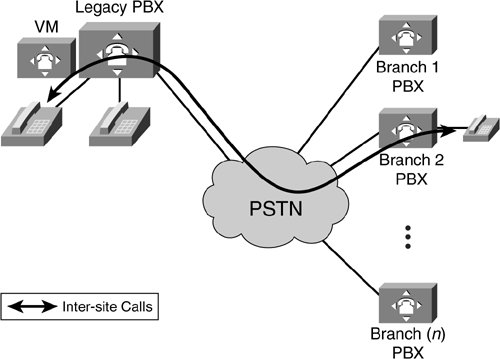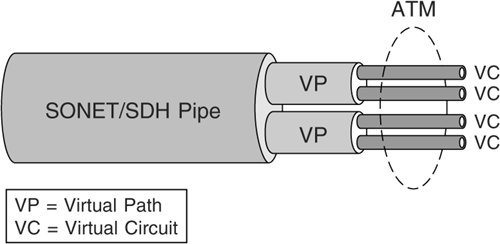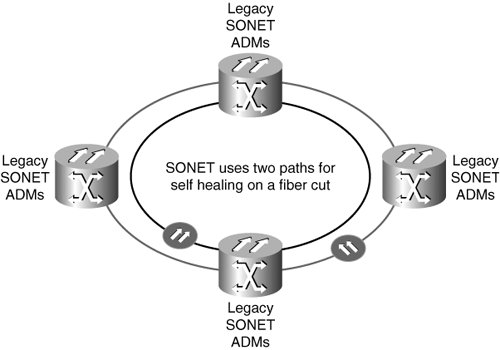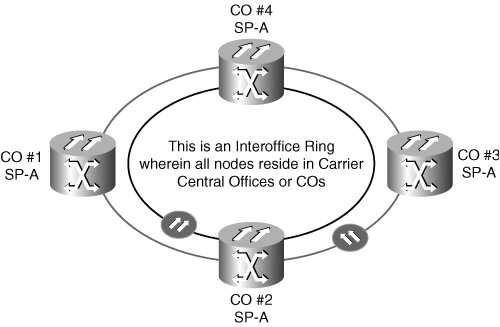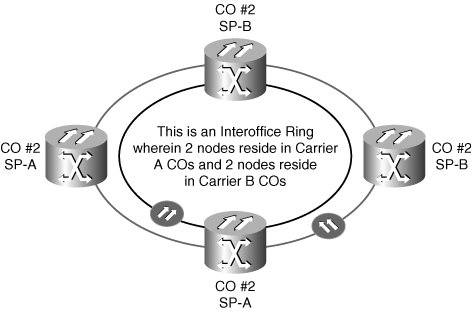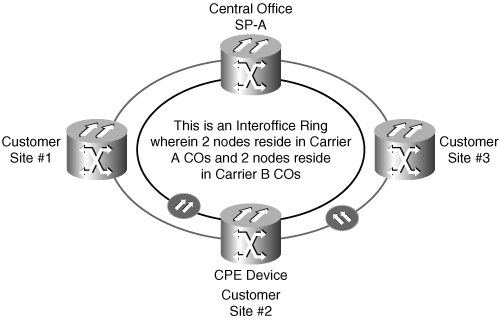Traditional Service-Provider Network Architectures
| Within Multiservice Provisioning Platform (MSPP) architectures there are traditional service-provider network architectures: the PSTN, Frame Relay/ATM, SONET IP/MPLS, and transport network types such as IOF, access, and private ring deployments. This chapter also covers heritage OSS because it plays such a large role in today's MSPP equipment providers' plans. Public Switched Telephone NetworksThose who are familiar with packet-switched routing, which is the backbone of the Internet and uses Internet Protocol (IP), know that the Internet is the amalgamation of today's data networks (see Figure 4-1). The public switched telephone network (PSTN), shown in Figure 4-2, is analogous to the Internet, in that it is the amalgamation of the world's circuit-switched telephone networks. Although the PSTN was originally a fixed-line analog telephone system network, it has evolved into an almost entirely digital network that now includes both mobile and fixed telephones. Figure 4-1. The Internet Amalgamating Numerous Data Networks Figure 4-2. PSTN Amalgamating Numerous PSTNs Just as there are many standards surrounding the Internet, the PSTN is largely governed by technical standards created by the ITU-T. It uses E.163/ E.164 addresses (known more commonly as telephone numbers) for addressing. The PSTN is the earliest example of traffic engineering used to deliver "voice service" quality. In the 1970s, the telecommunications industry understood that digital services would follow much the same pattern as voice services, and conceived a vision of end-to-end circuit-switched services, known as the Broadband Integrated Services Digital Network (B-ISDN). Obviously, the B-ISDN vision has been overtaken by the disruptive technology of the Internet. The primary section of the PSTN that still uses analog technology is the last-mile loop to the customer; however, only the very oldest parts of the rest of the telephone network still use analog technology for anything. In recent years, digital services have been increasingly rolled out to end users using services such as digital subscriber line (DSL) and ISDN. Many pundits believe that over the long term, the PSTN will be just one application of the Internet; however, the Internet has some way to go before this transition can be made. The quality of service (QoS) guarantee is one aspect that must improve in Voice over IP (VoIP) technology. In some cases, private networks run by large companies are connected to the PSTN only through limited gateways, such as a large private automatic branch exchange/telephone (PABX) system. A number of large private telephone networks are not even linked to the PSTN and are used for military purposes. The basic digital circuit in the PSTN is a 64-kbps channel that was originally designed by Bell Labs, called a DS0, or Digital Signal 0. To carry a typical phone call from a calling party to a called party, the audio sound is digitized at an 8 kHz sample rate using 8-bit pulse-code modulation. The call is then transmitted from the one end to the other through the use of a routing strategy. The DS0s are the most basic level of granularity at which switching takes place in a telephone exchange. DS0s are also known as time slots because they are multiplexed together in a time-division fashion. Multiple DS0s are multiplexed together on higher-capacity circuits so that 24 DS0s make a DS1 signal. When carried on copper, this signal is the well-known T-Carrier system, T1 (the European equivalent is an E1, containing 32 64-kbps channels). In modern networks, this multiplexing is moved as close to the end user as possible, usually into roadside cabinets in residential areas, or into large business premises. Figure 4-3 shows the customer DS0 as it passes through the local loop and into the central office (CO1), where it is "trunked" from one CO switch to another. From the switching network, the customer-premises DS0s can be "switched" to their destination. Figure 4-3. Trunking and Local Loop Architecture Relationship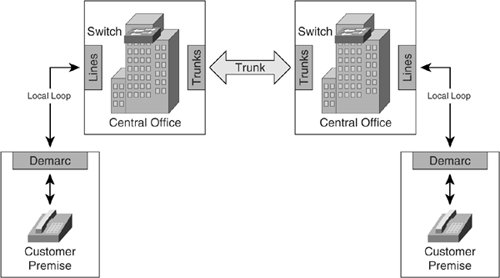 The time slots are carried from the initial multiplexer to the exchange over a set of equipment that is collectively known as the access network. The access network and interexchange transport of the PSTN use synchronous optical transmission (Synchronous Optical Network [SONET] and Synchronous Digital Hierarchy [SDH]) technology, although some parts still use the older Plesiochronous Digital Hierarchy (PDH) technology. PDH (plesiochronous means "nearly synchronous") was developed to carry digitized voice over twisted-pair cabling more efficiently. The local telephone companies, also known as local exchange carriers (LECs), service a given area based on geographic boundaries known as a local access and transport area (LATA). LATA is a geographic area that defines an LEC's territory. Calls that cross a LATA boundary must be carried by an interexchange carrier (IXC), as shown in Figure 4-4. Within the access network, a number of reference points are defined. Most of these are of interest mainly to ISDN, but onethe V reference pointis of more general interest. This is the reference point between a primary multiplexer and an exchange. Figure 4-4. Local Telephone Company COs Connected by Long-Distance, or IXE, Carriers Frame Relay/ATM NetworksFrame Relay is a traditional packet-based telecommunications service that takes advantage of characteristics of today's networks by minimizing the amount of error detection and recovery performed inside the network. Streamlining the communications process results in lower delay and higher throughput. Frame Relay offers features that make it ideal to interconnect local-area networks (LANs) using a wide-area network (WAN), as shown in Figure 4-5. Traditionally, LANs were interconnected by deploying private lines or by circuit-switching over a leased line. However, this approach has several drawbacks. The primary weakness of this legacy approach is that it becomes prohibitively expensive as the size of the network increases, in both the number of facility miles and the number of LANs. The reason for the high cost is that high-speed circuits and ports must be set up on a point-to-point basis among an increasing number of bridges. In addition, circuit-mode connectivity results in a lot of wasted bandwidth for the bursty traffic that is typical of LANs. Figure 4-5. Service Provider Frame Relay Networks Connected Through an ATM Network On the other hand, traditional X.25 packet-switched networks required significant protocol overheads and have historically been too slow at primarily supporting low-speed terminals at 19.2 kbps and lower. Frame Relay provides the statistical multiplexing interface of X.25 without its overhead. In addition, it can handle multiple data sessions on a single access line, which reduces hardware and circuit requirements. Frame Relay is also scalable, meaning that implementations are available from low bandwidths (such as 56 kbps) all the way up to T1 (1.544 Mbps) or even T3 (44.736 Mbps) speeds. Connection to the LANIn the past decade, significant advancements in computing and communications technology have reshaped the business milieu. With the cost of processing power falling, PCs and high-powered workstations have proliferated exponentially and are now an integral part of the end user's world. This has resulted in an explosion in the demand and use of personal computers, workstations, and LANs, and has altered the corporate information system. The major changes include the following:
Benefits of Frame RelayFrame Relay optimizes bandwidth because of its statistical multiplexing and low-protocol overhead, resulting in the following benefits of Frame Relay:
Asynchronous Transfer ModeFrame Relay and Asynchronous Transfer Mode (ATM) offer different services and are designed for different applications. ATM is better suited for applications such as imaging, real-time video, and collaborative computer-aided design (CAD) that are too bandwidth intensive for Frame Relay. On the other hand, at T1 speeds and lower, Frame Relay uses bandwidth much more efficiently than ATM. ATM is a dedicated connection-switching technology that arranges digital data into 53-byte cell units and transmits them over a physical medium using digital signal technology. Individually, a cell is processed asynchronously relative to other related cells and is queued before it is multiplexed over the transmission path. The prespecified bit rates are 155.520 Mbps or 622.080 Mbps, although speeds on ATM networks can reach 10 Gbps. Key ATM features include the following:
Carriers have traditionally deployed ATM for the following reasons:
Service Provider SONET NetworksNot much needs to be said here because the entire focus of this book is optical networking. Essentially, SONET is a synchronous transport system that uses dual rings for redundancy. SONET, used in North America, and SDH, used in Europe, are almost identical standards for the transport of data over optical media between two fixed points. They use 810-byte frames as a container for the transport of data at speeds of up to OC192 (9.6 Gbps). SONET/SDH is used as the bearer layer for higher-layer protocols, such as ATM, IP, and Point-to-Point Protocol (PPP), deployed on devices that switch or route traffic to a particular endpoint, as shown in Figure 4-6. The functions of SONET/SDH in the broadband arena are roughly analogous to those of T1/E1 in the narrowband world. The SONET/SDH standards define the encapsulation of data within SONET/SDH frames, the encoding of signals on a fiber-optic cable, and the management of the SONET/SDH link. Figure 4-6. A SONET/SDH Pipe Carrying ATM The advantages of SONET/SDH include the following:
IP and MPLS NetworksMultiprotocol Label Switching (MPLS) is one of the most exciting emerging network protocols in recent years. In MPLS, a short fixed-length label is created and applied to the front end of the IP packet; that acts as a shorthand representation of an IP packet's header (see Figure 4-8). Label-switched routers make subsequent routing decisions based on the MPLS label, not the original IP address. This new technology allows core network routers to operate at higher speeds without needing to examine each packet in detail. It also allows more complex services to be deployed, which enables discrimination on a QoS basis. Thus, an MPLS network is a routed network that uses the MPLS label to add another layer of differentiation to the traffic, enabling a global class of service (CoS) so that carriers can distinguish not only between customers, but also between types of service being carried through their network. Figure 4-8. MPLS Label An MPLS-based Virtual Private Network (VPN) basically uses a long IP address in which each site belongs to a VPN with an associated number. This enables you to distinguish duplicate private addresses. For example, subnet 10.2.1.0 for VPN 23 is different than subnet 10.2.1.0 for VPN 109. From the MPLS VPN provider's point of view, they are really 23:10.1.1.0 and 109:10.1.1.0, which are quite different. Thus, a customer data packet has two levels of labels attached when it is forwarded across the backbone, as shown in Figure 4-9:
Carriers can now use the IP/MPLS customer edge (CE) and provider edge (PE), as shown in Figure 4-10. This provides them with enhanced and more tightly defined service-level agreements (SLAs), cuts their infrastructure costs, and offers new services. Carriers can also use IP/MPLS to provide VPN services to distribute traffic loads more effectively throughout their networks, and to introduce SONET-like failover times to packet forwarding without incurring SONET-like costs. Figure 4-10. A Carrier IP/MPLS Backbone Connecting CE Routers to PE Routers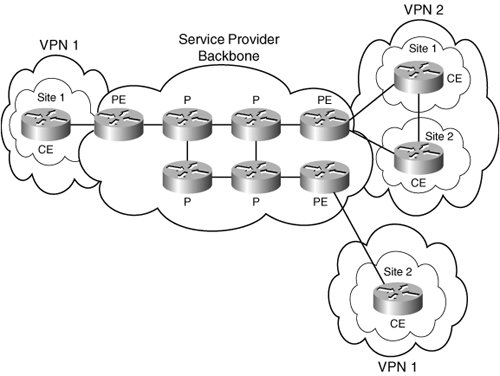 Transport NetworksThree major transport ring types exist for service providers: interoffice facilities (IOFs), access rings, and private rings. Network architectures are based on many factors, including the types of applications and protocols, distances, usage and access patterns, and legacy network topologies. In the metropolitan market, for example, point-to-point topologies might be used for connecting enterprise locations, ring topologies for connecting interoffice (IOF) facilities and for residential access, and mesh topologies for interpoint of presence (POP) connections and connections to the long-haul backbone. In effect, the optical layer must be capable of supporting many topologies. Because of unpredictable developments in this area, those topologies must be flexible. IOF RingsIOF rings can belong exclusively to a single carrier (as shown in Figure 4-11), as do almost all of them, or they can be a combination ring between two or more carriers, often called a midspan meet or simply a meet (shown in Figure 4-12). Some service providers consider these meets as IOF; other service providers consider the other carrier nodes on the ring as customer nodes. The main feature of IOF rings is that they are intended to carry traffic between COs, not to customers who are paying for services delivered off the ring. IOF rings are often configured as a bidirectional line switch ring (BLSR) because BLSR nodes can terminate traffic coming from either side of the ring. Therefore, BLSRs are suited for distributed node-to-node traffic applications such as IOF networks and access networks. Figure 4-11. IOF Ring Carrying Traffic Between COs of Same Carrier Figure 4-12. IOF Ring Carrying Traffic Between Two Different Carriers Access RingsAn access ring, shown in Figure 4-13, is a ring serviced out of a CO that provides services to the remote cabinets, controlled environmental vaults (CEVs), and huts that deliver service to the end customers. Plain old telephone service (POTS), ISDN, data services, and other special services are delivered from the access ring. Typically, the customer data is aggregated into a digital loop carrier (DLC). The DLC breaks DS1s into DS0s. The DLC DS1s are then aggregated and carried back to the CO over either T1s, asynchronous multiplexors, or an optical carrier (OC) ring. Figure 4-13. Access Ring Carrying Traffic Between the Carrier's IOF Ring and Remote Cabinets If the traffic requirement to any specific customer is too great to be carried back over the access ring, a private ring (discussed in the next section) is deployed for that customer's specific traffic. Thus, an access ring is differentiated from a private ring because it carries multiple customers' traffic. Carriers today are looking for new access ring solutions to fulfill their multiservice requirements, especially as the data-networking world has exploded and emerging services such as VoIP, Internet Protocol Television (IPTV), and broadband DSL are growing in popularity. However, these alternatives must be cost-effective and must provide incremental evolutionary upgrades. Technologies such as Metro Ethernet over SONET via Route Processor Redundancy (RPR) and even course wave-division multiplexing (CWDM) are being considered alternatives for access ring technologies. Private RingsAs mentioned in the last section, the need for a private customer ring emerges when the customer needs bandwidth that would exceed the availability of the carrier access rings. Figure 4-14 shows a deployment of a private ring in which the customer has three locations to connect and then homed back to the carrier CO to pick up other services, such as voice dial tone and Internet access. The traditional deployments of private rings provide primarily bandwidth for connectivity; special services such as Metro Ethernet, storage, and dense wavelength-division multiplexing (DWDM) wave-length services either could not be deployed or would require a separate network altogether. Figure 4-14. A Private Ring Deployment Featuring Multiple Customer Sites Thanks to MSPP, today numerous service types can be delivered to customers over private rings, including Ethernet, storage, and DWDM. The demand for services has become so great that service providers are replacing lost voice-revenue streams with managed service-revenue streams. In a managed service, the service provider owns all the network infrastructure and fully manages it, handing the customer a connection into the provider's network "cloud." This has been a great benefit to customers who do not have in-house expertise to manage WAN services, and it allows the customer to focus on the core competencies of their business. Service providers capitalize on the economies of scale by servicing hundreds to thousands of customers; therefore, providers can negotiate for better capital equipment prices with vendors and can draw from a huge trouble-reporting/-resolution database to resolve network problems more quickly. Thus, MSPP-based private rings offer both the service provider and the customer benefits that neither could obtain without this next-generation technology. Heritage Operational Support SystemBefore leaving traditional carrier network architectures, it is only appropriate that you consider some of the legacy OSS components. Not only have these components affected the large incumbent local exchange carrier (ILEC) networks in the past, but they are still greatly influencing their architectural decisions today as they try to evolve and transform their networks while being "attached" to these legacy OSS components. These systems have hindered transformation because they are so ubiquitously integrated into the network that changing any device in the network, or deploying a new technology, must accommodate their rules and conventions. This has greatly affected telecom equipment providers. If the providers want to sell their products to a Regional Bell Operating Company (RBOC), they must successfully complete the Operations Systems Modifications for the Integration of Network Elements (OSMINE) certification process. Many years ago, this process was only an internal process operated by the RBOCs. The RBOCs exclusively commissioned Telcordia Technologies, formerly Bellcore, to perform interoperability testing and device integration. Today Telcordia Technologies is the certification body that guarantees that a Network Equipment Provider's device is interoperable with a heritage Telcordia OSS, such as Trunk Integrated Record Keeping System (TIRKS), Transport Element Activation Manager (TEMS), and Network Monitoring and Analysis (NMA). Thus, Telcordia is the door through which equipment providers must pass to get a license to sell in the RBOC space. Telcordia also ensures service providers that the equipment providers' device interface conforms to the Telcordia-defined TL1 standards. TIRKS, TEMS, and NMA are covered in the next few sections. TIRKSTIRKS is an inventory record-keeping and provisioning system for interoffice trunk facilities. TIRKS has traditionally made record-keeping and assignment of central office equipment and interoffice facilities an efficient and easy process by accomplishing the following:
TEMSTEMS is Telcordia's Transport Network Element (NE) Activation Manager. TEMS (or Transport) is an element-management system used to provision and examine transport network elements. Additionally, TEMS provides memory-management functions and interfaces with upstream Telcordia OSSes, such as TIRKS. NMANMA is a fault-management OSS in service-provider networks. NMA is a device-monitoring and surveillance OSS that collects alarm and performance data from network elements. It continually receives alarm information from the equipment and correlates these alarms. NMA performs root-cause analysis by correlating multiple related alarm messages and then outputting a single trouble ticket. NMA tracks trouble tickets and uses these to identify the equipment and other facilities that require service restoration and maintenance by network technicians. To correlate alarms, NMA must understand the equipment architecture and the relationships between the equipment facilities. Therefore, for NMA certification, the chief output from OSMINE includes configuration files, known as NMA templates, which NMA uses to manage the equipment. Telcordia produces diagrams of the equipment's containment and support hierarchy. These diagrams are profiles of the multiple configurations of the equipment's racks, shelves, and circuit packs. Telcordia delivers a "Methods & Procedures" document to the equipment provider's customers that includes these diagrams, and instructs service providers on how to build and modify the hierarchies for the NE. |
EAN: 2147483647
Pages: 140

